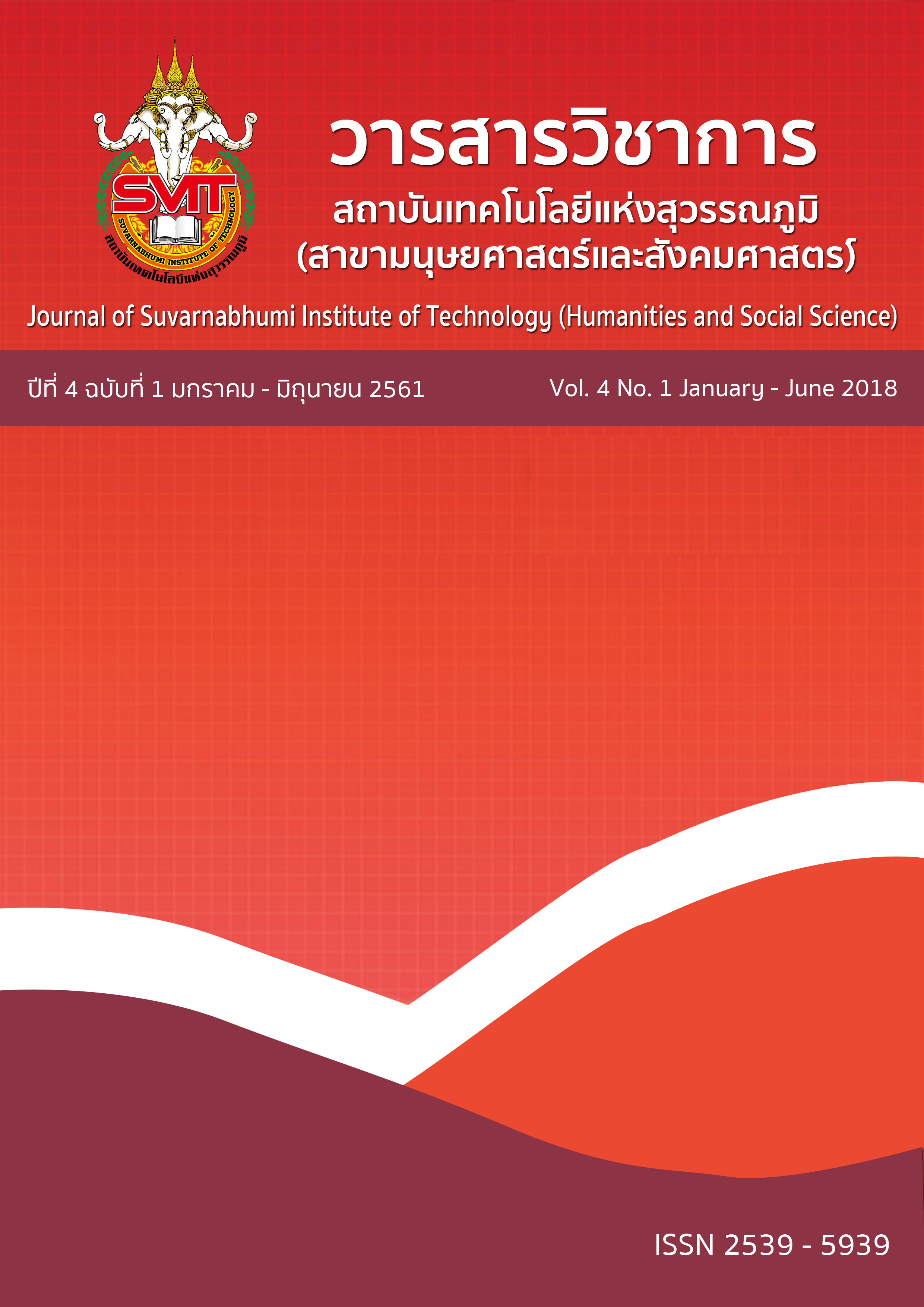A CONFIRMATORY FACTOR ANALYSIS OF OPERATIONAL EFFECTIVENESS AT LAEM KLAT SUB- DISTRICT ADMINISTRATIVE ORGANIZATION IN TRAT PROVINCE
Keywords:
ประสิทธิผลการดำเนินงานขององค์การบริหารส่วนตำบลแหลมกลัด, การวิเคราะห์องค์ประกอบเชิงยืนยันAbstract
The research namely “A Confirmatory Factor Analysis of operational effectiveness at Laem Klat Sub- District Administrative Organization in Trat Province” has the objectives to analysis the components of operational effectiveness and to investigate the concordance of operational effectiveness at Laem Klat Sub- District Administrative Organization in Trat province with the empirical data.There were 500 participants used as a sampling group and were selected by using a stratified random sampling technique, Participants from each village were randomly selected by Simple Random Sampling. A questionnaire with a fivepoint scale was used as the research instrument in this study. The model was validated using confirmatory factor analysis through Mplus Demo Editor program.
The research results indicated that operational effectiveness at Laem Klat Sub- District Administrative Organization in Trat province consisted of three factors. In order of factor loading they were: organizational productivity, goal organizational achievement and organizational adaptation. The model in accordance was fit with the empirical data with Chi-square X2 =0.000, df = 1, P-value = 0.998 , TLI = 1.004, RMSEA = 0.000, SRMR =0.000, CFI = 1.000, X2 / df = 0.000 Keywords: operational effectiveness, con firmatory factor analysis
References
เฉลิมพล ศรีหงษ์. (2543). ระเบียบวิธีวิจัย. ม.ป.ท.
ณัชชากร เอมเปีย. (2558). ปัจจัยที่มีอิทธิพลต่อประสิทธิผลการดำเนินงานด้านความปลอดภัยใน โรงงานประกอบรถยนต์แห่งหนึ่งในจังหวัดฉะเชิงเทรา. (วิทยานิพนธ์ ปรัชญาดุษฏีบัณทิต, มหาวิทยาลัย ราชภัฏราชนครินทร์).
ธงชัย สันติวงษ์. (2543). หลักการจัดการ. กรุงเทพฯ: ไทยวัฒนาพานิช.
วิภาดา คุปตานนท์.(2548). การศึกษาความสัมพันธ์ระหว่างวัฒนาธรรมองค์การกับประสิทธิผลขององค์การ. รายงานวิจัยฉบับสมบูรณ์, มหาวิทยาลัยรังสิต.
โศภิดา คล้ายหนองสรวง. (2558). การบริหารแบบมีส่วนร่วมที่ส่งผลต่อประสิทธิผลของสถานศึกษา. (วิทยานิพนธ์การศึกษามหาบัณทิต, มหาวิทยาลัยบูรพา).
สำนักงานคณะกรรมการข้าราชการพลเรือน. (2546). ระเบียบสานักนายกรัฐมนตรีว่าด้วย การสร้างระบบบริหารกิจการบ้านเมืองและสังคมที่ดี พ.ศ.2542. เข้าถึงข้อมูลเมื่อวันที่ 20 ธันวาคม 2560. เข้าถึงได้จาก http;//www.ocsc.go.th./Good Government/ GGH.pdf.
สมหมาย เทียนสมใจ (2556). รูปแบบการบริหารงานที่มีประสิทธิภาพของ สำนักงานพื้นที่การศึกษาประถมศึกษา. (วิทยานิพนธ์ปรัชญาดุษฏีบัณฑิต, มหาวิทยาลัยศิลปกร).
องค์การบริหารส่วนตำบลแหลมกลัด.(2560). แผนพัฒนาสามปี 2557-2560 องค์การบริหารส่วนตำบลนาแหลมกลัด อำเภอเมือง จังหวัดตราด. ม.ป.ท.
พงษ์เสฐียร เหลืองอลงกต. (2557). ความสัมพันธ์ระหว่างการบริหารงานตามหลักธรรมาภิบาลกับคุณภาพการบริการขององค์การบริหารส่วนตำบลนายายอาม อำเภอนายายอาม จังหวัดจันทบุรี.วารสารสุโขทัย ธรรมาธิราช, มหาวิทยาลัยสุโขทัยธรรมาธิราช, 27(1), 78 – 90.
Cameron, K.S.(1978) “Measuring Organizational Effectiveness in Institutions of Higher Educa-tion.” Administrative Science Quarterly 23: 604-632. Comrey, A. L., & Lee, H. B. (1992). A first course in factor analysis (2nd ed.). Hillsdale, NJ: Law-rence Erlbaum Associates.
Georgopoulos, B. S., & Tannenbaum, A. S. (1991). A study of organizational effectiveness. American Sociological Review, 22(5), 534-540.
Gerloff, E. A. (1985). Organizational theory and design: A strategic approach for manage-ment. New York: McGraw-Hill.
Gibson, J. L., Ivancevich, J. M. & Donnelly, J. H. (1973).Organizations: Structure, process, be-havior. Texas: Business Publications.
Gilley, A.; Gilley, J. W. & McMillan, H. S. (2009). Organizational Change: Motivation, Communication, and Leadership Effectiveness. Performance Improvement Quarterly. 21(4), pp. 75-94.
Hoy, W. K., &Miskel, C. G. (2001). Educational administration: Theory research and practice. New York: McGraw - Hill.
Hooper, D., Coughlan, J., & Mullen, M. (2008). Structural Equation Modeling: Guidelines for Determining Model Fit. Electronic journal of Business Research Methods. 6(1), 53-60.
Kotter, J. P. (1996). Leading Change. Boston: Harvard Business School.
Mason, C. M., Chang, A. C. F., & Griffin, M. A. (2005). Strategic use of employee opinion sur-veys: Using a quasi-linkage approach to model the drivers of organizational effective-ness. Australian Journal of Management, 30(1), 127-143.
Muthén, L. K., and Muthén, B.O. (2008).Mplus: The Comprehensive Modeling Program for Applied Researchers user’s guide, Version 5.21. Los Angeles, CA: Muthén & Muthén.
Onyango, W. P. (2014). Effect of organization culture management: A case of the vocational training centre for the blind and deaf sikri. European Journal of Business and Man-agement. 6(34), 204-214.
Parsons, T. (1994). Structure and process in modern societies. New York: The Press Clench.
Downloads
Published
Issue
Section
License
บทความที่ได้รับการตีพิมพ์เป็นลิขสิทธิ์ของวารสารวิชาการ สถาบันเทคโนโลยีแห่งสุวรรณภูมิ
ข้อความที่ปรากฏในบทความแต่ละเรื่องในวารสารวิชาการเล่มนี้เป็นความคิดเห็นส่วนตัวของผู้เขียนแต่ละท่านไม่เกี่ยวข้องกับสถาบันเทคโนโลยีแห่งสุวรรณภูมิ และคณาจารย์ท่านอื่นๆในสถาบันฯ แต่อย่างใด ความรับผิดชอบองค์ประกอบทั้งหมดของบทความแต่ละเรื่องเป็นของผู้เขียนแต่ละท่าน หากมีความผิดพลาดใดๆ ผู้เขียนแต่ละท่านจะรับผิดชอบบทความของตนเองแต่ผู้เดียว





